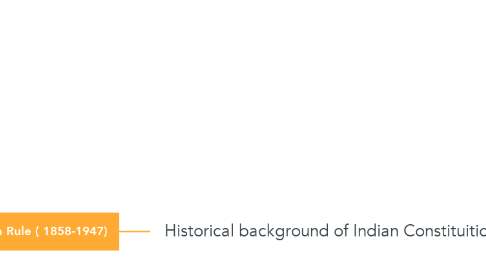
1. (1). The Company Rule (1773-1858)
1.1. (1). Regulating act of 1773
1.1.1. <1>. Governor of bengal said as Governor General of bengal <2>. First Governor general was Lord Warren Hasting <3>. Established of Supreme court at Calcutta 1774 <4>. Create Executive Council of four member.
1.2. (2). Amending Act of 1781
1.2.1. <1>. Power to make law for Bengal , Orrisa & Bihar <2>. This act Supreme court doesn't take action upon company senior level officer <3>. On time of made law and regulate it they can think about indian society and its Riti Rivaj
1.3. (3). Pitt's India Act of 1785
1.3.1. <1>. It distinguished b/w political affair and commercial affair <2>. For comercial affairs by Court of Directors & for Political affairs by Board of control <3>. It established double governance
1.4. (4). Act of 1786
1.4.1. <1>. Lord Cornwallis appointed for Governor general <2>. He should be power to override the decision of his council in special cases <3>. He would also be cammander-in-cheif
1.5. (5). Charter Act of 1793
1.5.1. <1>. It give powers to all future Governor-General to override his council decision in special case. <2>. It extend trade monopoly of company for 20 yr. <3>. Commander-in-cheif was not member of Governors council
1.6. (6). Charter Act of 1813
1.6.1. <1>. Act give freedom to christian missaniories for advertise <2>. 1 lack spend on Education <3>. Local bodies(gov.) take taxes from general people.
1.7. (7). Charter Act of 1833
1.7.1. <1>. Governor-general of bengal as Governor General of India. <2>. Lord William Bentick was the first Governor general of India. <3>. Inc the member council of Governor general to 4 & this member of law . <4>. First law member was Lord Macaulay
1.8. (8). Charter Act of 1853
1.8.1. <1>. It introduced for the first time, local representation in the indian (central) legislative council of six new legilative member of the Governor-General council. <2>. Separated first time, the legislative and executive functions of the Governor-General council.
2. (2) The Crown Rule ( 1858-1947)
2.1. (1). Government of India Act of 1858
2.1.1. <1>. These act is also known as Act of Good Government of India <2>. Act help to transfer power from gov. to British Government. <3>. Designation changed Governor General to Viceroy of india. <4>. Viceroy was direct representation of British Crown in India. <5>. Lord Canning was the first Viceroy of India. <6>. It ended system of Double governance. <7>. It create new office , secretory state of India.
2.2. (2). Indian Council Act of 1861
2.2.1. <1>. It initiated the process of decentralisation by restoring power to the Bombay and Madras presidency estate. <2>. Vikendriyakran suru kiya gya, jo power central ko diya gya tha by regulating act 1773 dwara central ko ab power state ko diya gya
2.3. (3). Act of 1873
2.3.1. <1>. East India company ko kv v khatm/bhang kiya ja skta hai. ( 1 jan 1884 ko isse bhang kr diya gya)
2.4. (4). Act of 1876 (Sahi upadhi Adhiniyam)
2.4.1. <1>. 28 april 1876 ko Queen Elizabeth ko India ki Queen khosit kiya gya
2.5. (5). Indian Council Act of 1892
2.5.1. <1>. Bhartiy sadasyo/member ko Budget me baithne/question krne ka right mil gya. <2>. But supplementary/counter question ni kr skte the.
2.6. (6). Indian Council Act of 1909
2.6.1. <1>. This act is also known as Marley-Minto reform. <2>. It considerably inc the size of the legilative both central & provinicial. <3>. Number of Central legislative council was raised from 16 to 60. <4>. Member to allowed to ask counter question. <5>. For the time the association of indians with the executive council of the Viceroy . <6>. "Satendra Prasad Sinha" became first Indian to join council. <7>. It indroduced communal representation.(ex. Muslim can elect muslim members).
